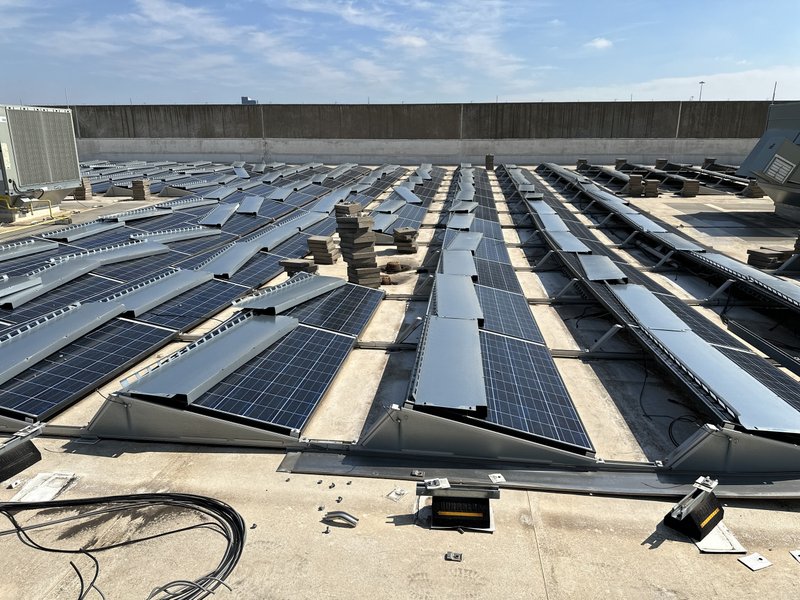The Pitch | How Tigo Pure Signal helps avoid cross talk in C&I solar

Earlier this year, Tigo Energy enhanced its module-level power electronics with Pure Signal technology, which they say affords solar installers more margin for error when designing large, complex systems for commercial and industrial applications.
How does it work? And how else can installers avoid cross talk and other MLPE related issues? JD Dillon, chief marketing officer of Tigo Energy, joined us on The Pitch to answer those questions and more.
We discuss:
- Why do we need rapid shutdown?
- Explanation of cross talk
- What are design, install issues that cause cross talk?
- Best practices for avoiding cross talk
- What is Pure Signal? What does it do?
- How many fewer cross talk issues can we expect?
- How many inverters in Pure Signal compatible with?
- How have the failure rates of Tigo’s product improved over time?
Here is part of the transcript covering cross talk and what Pure Signal does to mitigate it.
2:09: Before we get into Pure Signal, what is cross talk?
Dillon: It basically happens when there’s two wires too close to each other. This happens in [power line communication], it does not happened in wireless, so it’s limited not only to wired communication, but it’s limited to when the wires are too close together. So it can occur a variety of different ways but we really only see it in very large systems with lots of inverters installed.
2:36 The issue is a little bit of design and installation best practices even more so than technology. Can we drill a bit more into the design and install side of things?
At Tigo, our goal is to fix the issue not to blame. The solar industry has determined that there are three problems that lead to any sort of installation mistakes or problems: Design flaws, faulty installation and equipment defects.
The funny thing about this, every one of the equipment providers such as Tigo says it’s a design issue, it’s an installation issue, and I can tell you if you had an installer in here right now, he or she would say ‘no, it’s the equipment.’ But again we want to fix the problem not the blame.
3:28 What are some more of those best practices to be aware of when it comes to avoiding crosstalk issues and how do installers best make sure that their designs will not run afoul of crosstalk issues?
Dillon: Tigo’s leading the way with a four-point quality initiative. Now, we want to preempt the design flaws; we want to mitigate installation faults; reduce solution errors; and decrease component defects. We want to do the complete solution from design to installation to the components.
First of all, it starts with an early risk assessment. In order to preempt the design flaws we developed a tool. This tool is not an on-site tool, it’s an in the office tool. You call it up on the web, there’s 11 simple questions. If it comes up green after you answer the questions, you’re good to go. If it’s red, give us a call. And if it’s yellow, you ought to get to it, but it’s kind of middle of the road.
This risk assessment for installation by the way works with Tigo and non-Tigo systems, so that’s on our website.
Second of all is training. We have a design and installation course for our TS4, which is our product line for optimization monitoring and rapid shutdown. It’s self-paced and gives you some NABCEP credit hours. A great guy by the name of Greg Smith teaches it, and it’s only two hours.
After you do the training of course there’s documentation. Unfortunately, if you’re like me, I’m not a real manual reader — you can just ask my wife about that — but we have explicit documentation because hopefully more of our customers are. It spells out exactly what they do.
5:23 So now we add in Pure Signal technology after we use the tool to configure our design. What exactly is Pure Signal technology and what is it doing differently?
Dillon: Pure Signal is essentially a technology that goes on top of our transmitter and the Pure Signal technology reduces the impact of electromagnetic interference. In layman’s terms, it gives you more margin for error. If your design is a little bit too close together, it still works. If you don’t always follow everything in our manual, it still should work.
Now that doesn’t mean that you should follow poor design practices, but it’s a very useful technology nonetheless.
We took it out to Catalyze, a wonderful installer, and let me read here what the director of construction said: “Pure Signal technology helped us avert a significant amount of rework after a design review showed that some of our cable runs could be at risk of crosstalk issues.” He is testifying to exactly what this technology was designed to do.
Pick up the conversation right here to better understand how much margin for error we’re talking about, how many inverters Pure Signal is compatible with and how Tigo has improved the failure rates of its rapid-shutdown-only TS4s along the way.





Comments are closed here.